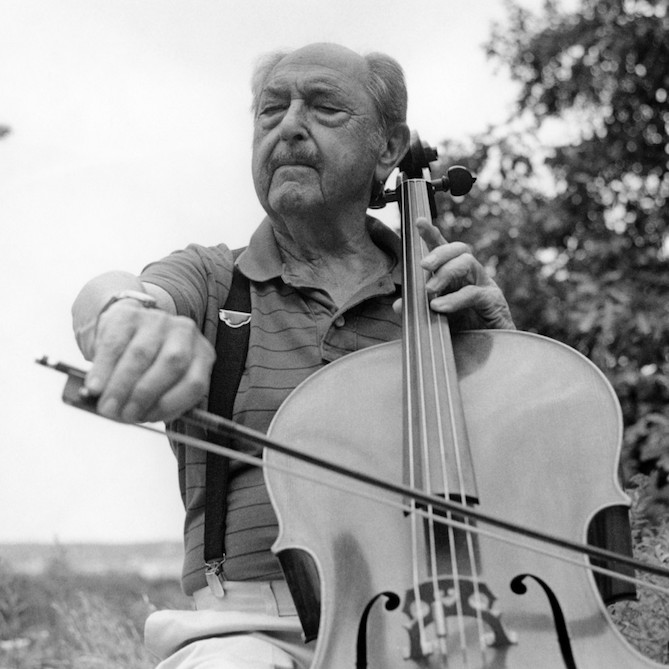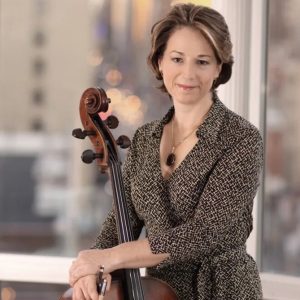
Reflections on the Legacy of Bernard Greenhouse
Kate Dillingham
I first met Mr. Greenhouse in 1986 when I was a scholarship student at Mason Gross School of the Arts at Rutgers University in New Brunswick, New Jersey. The Beaux Arts Trio gave a memorable concert at the school in their final year in the configuration of Messieurs Pressler, Cohen and Greenhouse. Little did I know that one year later, Mr. Greenhouse would retire from the Trio and become my teacher.
Our lessons always began with some light-hearted humor to prepare me for understanding the depth of commitment to daily practice and study I needed to cultivate. Greenhouse emphasized striving for continuous growth as an artist. He insisted on developing acute listening skills, being thoroughly familiar with the score and having the courage to believe in my musical convictions.
Greenhouse taught me that the quality of the sound one is creating and mindfulness of dynamics, articulation and rhythm are paramount in one’s ability to communicate musical ideas to the audience. He believed he could teach interpretive skills: to develop a technique of left hand and bow coordination essential in finding one’s own voice in structuring a musical work, be it that of Bach, Beethoven, Schumann or a contemporary composer. Click here to view a video entitled “Back to Bach” with Bernard Greenhouse.
Interpretive skills, as indicated by Greenhouse, require awareness: freedom in the physicality of playing the cello, balance and elasticity in left hand technique, and creative use of the bow. Making use of the whole palate of the area of the string between the end of the fingerboard and the bridge. Varying the speed, pressure and placement of the bow on the string and coordinating it with the left hand to assure accuracy in shifts and in passagework. Greenhouse emphasized that, “We always have more time within a phrase, or during a shift, than we think we do!”
Bernard Greenhouse had infinite variety of color in his vibrato. He developed three distinct and independent techniques employing the whole arm, the wrist, and the finger. He spoke about the sensitivity of touch: caressing the string to bring out the fullness of the cello’s range and capacity to express emotion. He encouraged me to identify every opportunity to be expressive and to use those opportunities to develop my voice at the instrument. He also taught me to beware of being satisfied too soon.
Greenhouse insisted on the ability to allow the note to speak with clarity by engaging the string with the fingers on the bow, to sustain through the note and to finish the note with follow through of the bow stroke and the vibrato. He put a great deal of emphasis on articulating left hand passage work with percussive fingers on the string to allow the notes to resonate and carry in a concert hall. He strove to encourage me to create direction in my phrasing, to play in a way that indicates forward motion in the music. He had an uncanny (and sometimes hilarious) ability to exaggerate whatever he objected to in my playing and imitate it to show me how I needed to listen to myself and become my own teacher.
Greenhouse felt that contact with composers and other artists was important for my development and that collaboration was not only artistically satisfying, but necessary to further the art form. He was a very honest performer and that quality existed in his teaching. He didn’t teach me in an “academic” way, and what he did teach came from his own hard work and life-long experience as a performer.
Almost 25 years later, as I listen to a now out-of-print recording of the Sonatas of J.S. Bach BWV 1027-1029 played by Bernard Greenhouse and harpsichordist Sylvia Marlowe, I am reminded of the influence this great artist and teacher had on my life as a student of the cello and music. I will always be grateful for what I learned from him and for the relationship we shared.
I remember visits to his home on beautiful Cape Cod, playing for him, honing my skills as an artist and appreciating the miracle that is a career in music. On one such occasion, he opened a bottle of Armanac he purchased in 1946 when he was studying with Casals in Prades. He regaled me with stories of his work with Casals and the Trio and it is clear to me that his great artistry was the result of a long process of trial and error; always striving to express his musical ideas with clarity. I remember, when I was feeling a bit nervous about a particular concert, he said, “This is not the first concert you’ve played, nor will it be the last.” I find those words to still be of great comfort today.
Subjects: Artists
